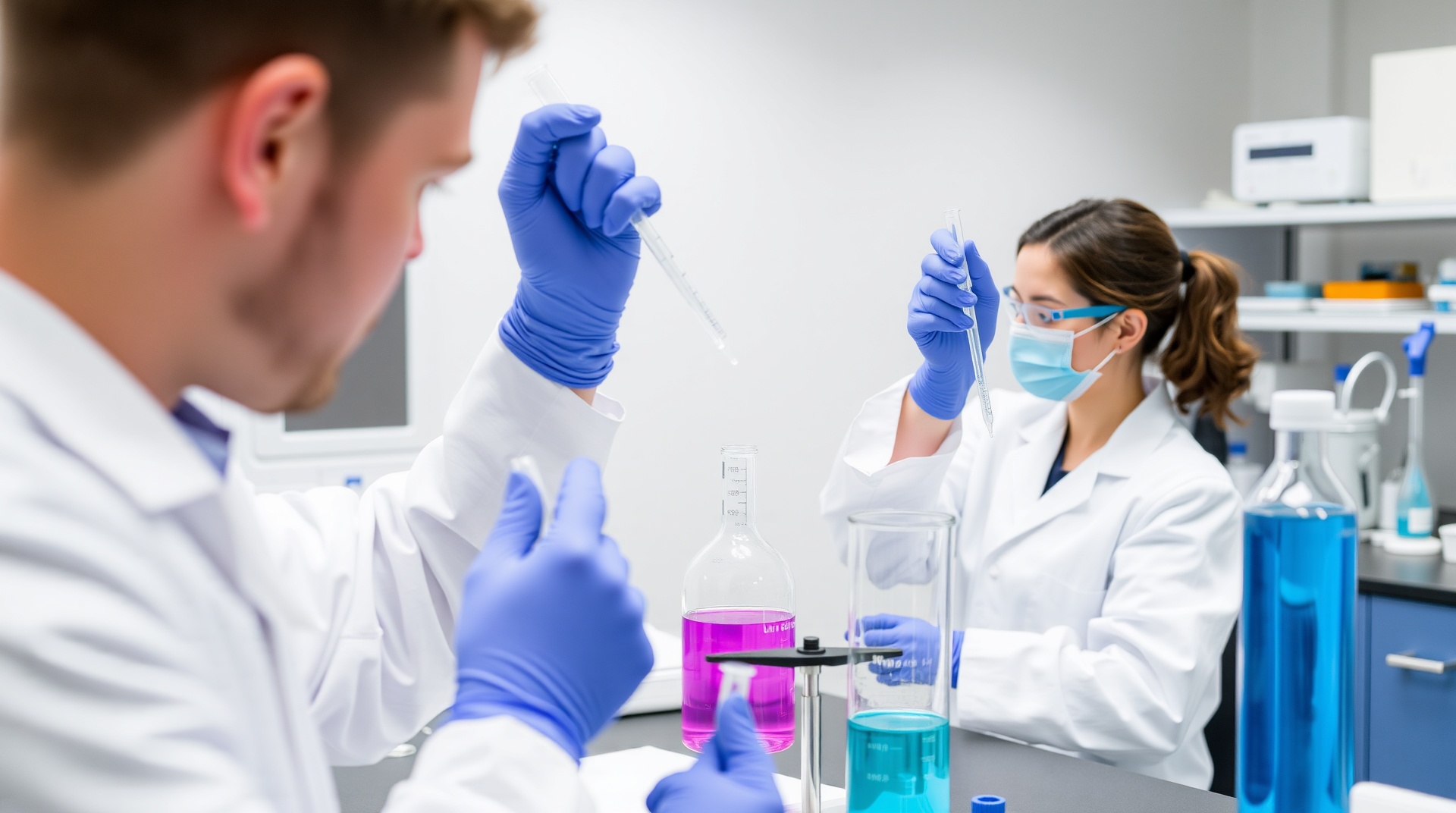
Solution DilutionCalculator
Calculate any unknown variable using the dilution formula C1V1 = C2V2 for lab preparation and solution concentration adjustment.
How to Use
- 1Enter values for three of the four variables: Initial Concentration (C1), Initial Volume (V1), Final Concentration (C2), and Final Volume (V2)
- 2Leave one field blank - this is the variable you want to calculate
- 3Click "Calculate Missing Variable" to get your result
- 4The calculator will display the missing variable with appropriate units
Dilution Formula
The Dilution Equation
C₁V₁ = C₂V₂
Where:
- • C₁ = Initial (stock) concentration
- • V₁ = Initial (stock) volume
- • C₂ = Final (diluted) concentration
- • V₂ = Final (diluted) volume
Example Calculation
Problem: How much 10 M stock solution is needed to make 100 mL of 1 M solution?
Given: C₁ = 10 M, V₁ = ?, C₂ = 1 M, V₂ = 100 mL
Solution: V₁ = (C₂ × V₂) / C₁ = (1 × 100) / 10 = 10 mL
Answer: Take 10 mL of 10 M stock and dilute to 100 mL total volume
Dilution Process Visualization
Diagram: Step-by-step dilution process showing how concentrated stock solution is diluted with solvent to achieve desired final concentration.
Key Steps:
- • Calculate required stock volume
- • Measure stock solution accurately
- • Add solvent to reach final volume
- • Mix thoroughly for homogeneity
Important Notes:
- • Always add solvent to solute
- • Use volumetric flasks for accuracy
- • Account for temperature effects
- • Label solutions immediately
Serial Dilution Process
Diagram: Serial dilution process showing progressive dilution steps to achieve very low concentrations through multiple dilution stages.
Serial Dilution Steps:
- • Start with stock solution (e.g., 1 M)
- • First dilution: 1:10 (0.1 M)
- • Second dilution: 1:100 (0.01 M)
- • Continue as needed
Applications:
- • Bacterial culture dilutions
- • Enzyme assay preparations
- • Standard curve generation
- • Quality control testing
Understanding Solution Dilution
Solution dilution is a fundamental laboratory technique used to reduce the concentration of a solute in a solution by adding more solvent. The principle is based on the conservation of mass - the amount of solute remains constant, but the volume increases, resulting in a lower concentration. This technique is essential in analytical chemistry, biochemistry, and countless laboratory applications.
The dilution formula C₁V₁ = C₂V₂ represents the conservation of moles or mass of solute. This relationship holds true regardless of the concentration units used, making it universally applicable for molarity, molality, normality, or percentage concentrations. Understanding this principle is crucial for accurate laboratory work and quantitative analysis.
In practice, dilutions are commonly expressed as ratios (1:10, 1:100) or factors (10-fold, 100-fold). A 1:10 dilution means one part of stock solution is mixed with nine parts of solvent, resulting in a 10-fold decrease in concentration. Serial dilutions extend this concept, creating a series of progressively more dilute solutions by performing multiple dilution steps.
Common applications include preparing standards for calibration curves, adjusting concentrations for biological assays, and creating working solutions from concentrated stocks. In microbiology, serial dilutions are used for bacterial enumeration and antibiotic susceptibility testing. Pharmaceutical laboratories use dilutions for drug concentration adjustments and quality control testing.
Accuracy in dilution preparation is critical for reliable results. Volumetric glassware should be used for precise measurements, and temperature effects on volume should be considered. Proper mixing ensures homogeneity, and immediate labeling prevents confusion. Understanding dilution principles also helps in troubleshooting analytical problems and optimizing experimental protocols.
Types of Dilutions and Applications
Simple Dilution
- • One-step dilution process
- • Direct application of C₁V₁ = C₂V₂
- • Used for moderate concentration changes
- • Common in routine laboratory work
Serial Dilution
- • Multiple sequential dilutions
- • Achieves very low concentrations
- • Essential for microbiology
- • Used in standard curve preparation
Laboratory Applications
Analytical Chemistry
Standard preparation, calibration curves, sample dilution for analysis
Biochemistry
Enzyme assays, protein dilutions, buffer preparation
Microbiology
Colony counting, antimicrobial testing, culture preparation
Related Calculators
Calculate Missing Variable
User Reviews
Based on 3 reviews
Dr. Rachel Kim
1 week agoPerfect for lab preparation! The C1V1=C2V2 calculator works flawlessly. Makes dilution calculations so much easier for my students.
Alex Chen
2 weeks agoExcellent tool for analytical chemistry. The interface is intuitive and calculations are always accurate. Highly recommended!
Prof. Michael Davis
3 weeks agoGreat calculator for teaching dilution concepts. Students find it very helpful for understanding the relationship between concentrations and volumes.
Frequently Asked Questions
Need More Biology Tools?
Explore our comprehensive collection of biology calculators
Explore More Biology Tools